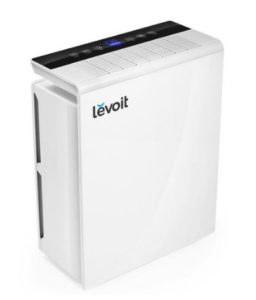When looking to buy an air purifier, the jargon used can leave you feeling confused. Below, we explain the main terms that you will come across when reading air purifier reviews.

What is CADR? What is True HEPA? – All the terms explained
These are just some of the questions you may need answers to in regards to air purifiers. In this section, we explain all the technical terms to help you better understand how air purifiers work.
Air purifier
An air purifier is a device that cleans the air by removing pollutants from the indoor air.
HEPA filter/ True HEPA filter
High-efficiency particulate air (HEPA) is a term that refers to an efficiency standard of an air filter. To be labeled a True HEPA filter, the filter must remove at least 99.97% of particles whose diameter is greater than or equal to 0.3 microns.
HEPA filters are made up of a layer of randomly arranged membranes. These filters usually target smaller pollutants which are trapped by the fiber.
Activated Carbon filter
Activated carbon filters comprise of small pieces of charcoal that are porous and clean the air by attracting chemicals in the pollutants as the air goes through the air purifier. Air purifiers fitted with activated carbon filters are best suited to remove particles that create odors and contain chemicals because these particles are too small for HEPA filters.
Pre-filters
These are filters placed at the start of the filtration process to capture large particles such as dust and hair. The large particles would reduce the effectiveness of other filters designed to capture small particles thus increasing the replacement costs. To keep the pre-filters clean, regular washing and vacuuming are needed.
Ozone generators
Ozone refers to a molecule that carries three oxygen atoms rather than two with the extra atom making the molecule to be very reactive. Therefore, to protect your health, look for air purifiers that are proven to produce zero ozone.
Ionizers
Ionizers are air purifiers that rely on charging particles and forcing them to stick together and avoid circulating in the room. While the air seems cleaner, the pollutants are still attached to various surfaces within the room. Air purifiers using this technology are considered less efficient than HEPA purifiers because they can trigger allergic reactions.
Clean Air Delivery Rate (CADR)
The Clean Air Delivery Rate (CADR) measures how fast an air purifier removes pollutants in the air. An air purifier with a high CADR removes pollutants faster than one with a lower CADR.
Air Changes per Hour (ACH)
The ACH measures how often an air purifier exchanges the air in a room within an hour. The ACH rating indicates the efficacy of an air purifier to clean indoor air. A higher number of air exchanges within an hour indicate better air quality.
AHAM Certification
The Association of Home Appliance Manufacturers (AHAM) certification is given to air purifiers that meet the required clean air delivery rate standards.
Noise level
While air purifiers clean indoor air to improve your wellbeing, they produce noise to a certain degree. A loud device can become a problem when it disrupts sleep or conversations. If you are sensitive to noise, then you should consider choosing an air purifier with lower decibel ratings or one whose noise levels can be reduced to suit the setting.
For instance, a good air purifier for baby rooms must not be very loud. Otherwise, the baby won’t be able to sleep.
UV-C filter
UV-C filter is used in air purifiers and uses electromagnetic radiation to kill mold spores, germs, bacteria, mildew, and viruses. To destroy air pollutants, UV-C air purifiers are use short-wave ultraviolet light. UV-C technology is also called a UV germicidal lamp.
PlasmaWave
A PlasmaWave air purifier uses ionizers to charge small particles and force them to stick together making it easier for the filters to capture them. The pollutants targeted by the PlasmaWave air purifiers include dust and pollen.
Conclusion
When it comes to air purifiers, the terminologies used can make it difficult to understand the key specifications to look out for. We hope this discussion has helped you fully understand the key terms associated with air purifiers.
Also, we have used simple language to allow everyone to understand the features so as to make a well-informed decision.